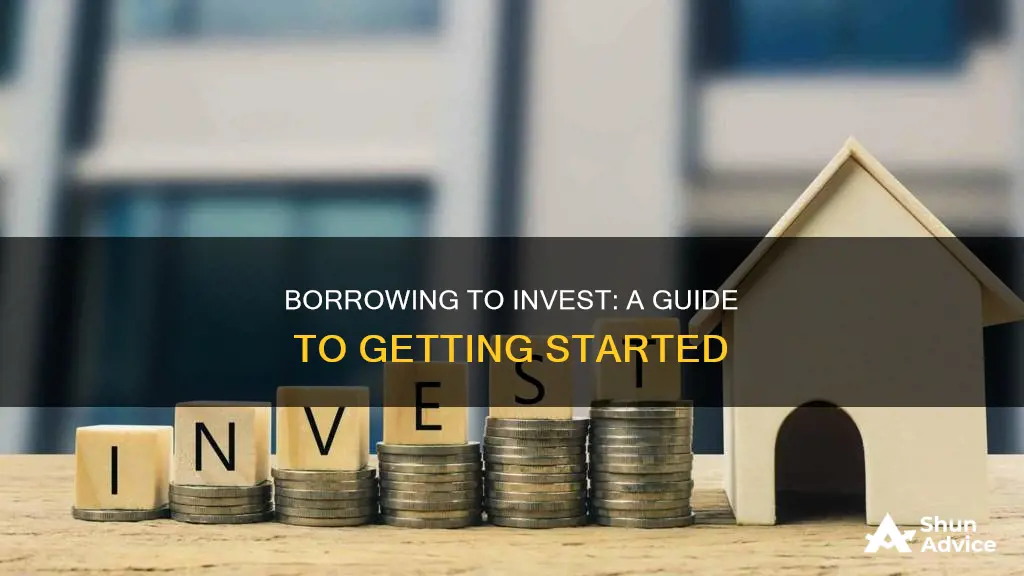
Borrowing to invest can be a risky strategy, but it is one that many successful investors have used to reach their personal and financial goals. While it may be tempting to take out a personal loan to invest, this strategy comes with multiple risks that may not be worth the potential reward. The primary risk of taking out a loan to invest is the potential for magnified losses. If the investment performs poorly, you are still obligated to repay the borrowed funds, including interest, which could lead to significant financial losses.
However, borrowing to invest can increase your returns by allowing you to purchase more than your current cash balances allow. It can also be a good strategy for those pursuing career growth, boosting their earnings, or those with excellent credit.
| Characteristics | Values |
|---|---|
| Risk | High |
| Returns | Amplified |
| Interest | Tax deductible |
| Loan type | Personal loan, home equity loan, margin loan, investment property loan |
| Investor type | Experienced, high-risk tolerance, stable financial situation |
| Investment type | Low-risk, high-return |
| Credit score | Excellent |
| Investment knowledge | High |
What You'll Learn

Weigh up the risks and your risk tolerance
Before investing with a loan, it is crucial to assess your risk tolerance and ensure you are comfortable with the potential downsides. Ask yourself the following questions to determine your risk tolerance:
- What are your investment goals? Understanding why you are investing is the first step towards knowing how much risk you are willing to take. Common goals include paying for a child's education or achieving financial independence.
- What is your time horizon? Generally, the longer your time horizon, the more risk you can take. For example, if you are saving for retirement, you have a longer time frame for your investments to recover from any potential losses. On the other hand, a shorter time horizon, such as saving for a down payment on a house, means your investments have less time to recover from a downturn.
- How comfortable are you with short-term losses? Investments can fluctuate in the short term, and it's important to remember that with stocks and similar investments, your shares may decline in value, but you don't realise the loss until you sell. If you are investing for the long term, you can hold on to the investment, hoping it will recover and potentially increase in value over time.
- Do you have non-invested savings? It is important to have some savings set aside in liquid accounts, regardless of your risk tolerance. This will ensure you have easily accessible cash in case of an emergency. However, if you are keeping a large portion of your savings in cash because you are nervous about investing, this may indicate that you are risk-averse.
- How often do you plan to track your investments? If you plan to track your investments frequently, ask yourself why. Are you doing it because you are nervous, or because you are excited about new investing opportunities? If every down day in the market makes your stomach drop, a diversified portfolio and a focus on long-term goals can make the inevitable downturns more bearable.
It is also important to understand the different types of investment risk and how they can impact your investments. Some common types of investment risk include:
- The tendency for prices to increase over time, which can reduce the buying power of your future investments.
- The risk to savings and loan rates if interest rates change. While increased interest rates are generally positive for money you are investing, they are negative for money you are borrowing.
- The risk of loss due to financial market performance. Stocks, for example, can vary from day to day and year to year.
- The risk of outliving your savings, as the length of retirement is undetermined, making it challenging to know how much money you will need.
- Credit risk, which is the risk of default by the issuer of a bond. In this case, bondholders may not receive the promised interest or full principal.
Additionally, when deciding whether to invest with a loan, consider the following factors:
- Investment knowledge: Before borrowing money to invest, ensure you are fully aware of the different types of investments and their associated risk levels.
- Current loan rates: Financial institutions often set their interest rates based on the federal funds rate. When the economy is down, the Federal Reserve may lower the federal funds rate, which could lead to lower interest rates on consumer lending products.
- Financial portfolio: Borrowing to invest requires a keen understanding of the market, the risks and returns of each investment vehicle, and a solid grasp of your risk tolerance. Consult an investing advisor to determine if taking out a loan to invest aligns with your financial goals and risk tolerance.
Remember, investing with a loan is not suitable for every investor. It is generally more appropriate for experienced investors with higher risk tolerance, a stable financial situation, and a clear understanding of the potential benefits and drawbacks.
MACD for Hourly vs Daily Investing: Which Timeframe Wins?
You may want to see also

Assess if it's suitable for your financial goals
Before deciding to take out a loan to invest, it is crucial to assess your financial situation, risk tolerance, and overall financial goals to determine if this strategy aligns with your financial plan. Here are some key factors to consider:
Financial Situation
It is important to evaluate your current financial situation, including your income, expenses, existing debts, and credit score. Ask yourself if you can comfortably afford the monthly loan payments, regardless of the performance of your investments. Ensure that you have a steady income and a good credit score. A higher credit score will give you access to lower interest rates, reducing the overall cost of the loan.
Risk Tolerance
Taking out a loan to invest is a risky strategy as it increases the overall risk in your investment portfolio. Assess your risk tolerance and ensure you are comfortable with the potential for amplified losses. Understand that you could lose more money than you initially invested and be prepared for this possibility.
Investment Goals
Consider your investment goals and time horizon. Are you investing for retirement, to buy a house, or to start a business? Ensure your investment goals are realistic and achievable. Taking out a loan to invest is generally more suitable for long-term goals as it may take time for the returns on your investments to materialize.
Investment Knowledge
Before taking out a loan, ensure you have a solid understanding of the investments you plan to make and the associated risks. Consult with a financial advisor to help you gauge if taking out a loan to invest aligns with your financial situation and goals.
Alternative Options
Before taking out a loan, explore alternative options such as using your own savings or income to invest. Consider if you can afford to put money into a high-yield savings account or invest gradually through fractional investing.
In conclusion, taking out a loan to invest may be suitable for your financial goals if you have a stable financial situation, a high risk tolerance, and a clear understanding of the potential benefits and drawbacks. However, it is important to carefully assess your circumstances and seek professional advice before proceeding.
Shareholder Cash: Is It a Company Asset?
You may want to see also

Understand the market and different investment vehicles
Understanding the market and different investment vehicles is crucial before investing with a loan. Here are some key points to consider:
Investment Vehicles
Investment vehicles refer to the various methods or instruments used by individuals or organisations to invest and grow their money. These include:
- Ownership Investments: Stocks, real estate, precious objects, and businesses. Stocks give investors ownership and a share of a company's profits and gains. Real estate can provide rental income or capital appreciation. Precious objects like art or collectibles can be sold for a profit.
- Lending Investments: Bonds, certificates of deposit (CDs), and Treasury Inflation-Protected Securities (TIPS). These are low-risk, low-reward investments where investors lend money with the expectation of repayment with interest.
- Pooled Investment Vehicles: Mutual funds, pension funds, hedge funds, and exchange-traded funds (ETFs). These allow multiple investors to pool their money, providing diversification and access to expert financial management.
- Other Vehicles: Annuities, cash equivalents, cryptocurrencies, money market accounts, health savings accounts, and retirement accounts. Each of these has unique characteristics in terms of risk, liquidity, and expected returns.
Understanding the Market
When considering investing with a loan, it's important to assess the market and your financial goals:
- Risk Tolerance: Different investment vehicles carry varying levels of risk. Stocks, options, and futures are generally riskier than CDs or bonds. Understand your risk tolerance and ensure any investments align with your comfort level.
- Financial Goals: Consider your short-term, medium-term, and long-term financial objectives. Choose investment vehicles that match your time horizon and expected returns. For example, if you're saving for retirement, opt for vehicles with long-term growth potential.
- Market Knowledge: Stay informed about market trends, performance, and regulations. This knowledge will help you make more informed investment decisions and better manage your portfolio.
- Investment Costs: Be mindful of the costs associated with different investment vehicles, such as management fees, commissions, and taxes. These costs can impact your overall returns, so it's essential to factor them into your decision-making.
- Diversification: Diversifying your portfolio across multiple investment vehicles can help minimise risk. By spreading your investments, you reduce the impact of any single investment's performance on your overall financial goals.
UBS's Cash Position: Strategic Investment Opportunities
You may want to see also

Know the pros and cons of borrowing to invest
Borrowing to invest can be a risky strategy, and it is not suitable for every investor. It is generally more appropriate for experienced investors with a higher risk tolerance, a stable financial situation, and a clear understanding of the potential benefits and drawbacks.
Pros:
- Amplified returns: Borrowing to invest can increase your returns by allowing you to purchase more than your current cash balances allow. The potential for amplified returns is the main advantage of borrowing to invest. By using borrowed funds, you can acquire a larger position than with your own existing cash balance alone. If the investment performs well, the leverage will increase your returns, enabling you to pay back the loan and still realize a substantial profit.
- Flexibility: Borrowing to invest gives you the flexibility to buy a range of assets or securities that you might not otherwise be able to afford.
- Potential to earn more than interest paid: If you can borrow money at a low interest rate to invest in a vehicle with high returns, you can potentially earn more than you would pay in interest.
Cons:
- Interest and fees: You will still have to pay interest and other fees on the loan, which can reduce or negate any potential gains from your investments.
- Worsening debt-to-income ratio: Borrowing to invest can worsen your debt-to-income ratio, which can have negative consequences for your financial situation and credit.
- Amplified losses: If your investments perform poorly, your losses will be amplified. This can result in margin calls or default, and you may have collateral seized if you are unable to repay the loan.
- Credit score damage: If you are unable to repay the loan, your credit score may be damaged.
- Risk tolerance: Borrowing to invest requires a higher-than-average degree of risk tolerance. It is not suitable for risk-averse investors or those with limited financial resources.
- Short-term financial needs: If you have short-term financial needs or goals, borrowing to invest might not be appropriate, as the returns on your investments may not materialize quickly enough to repay the loan on time.
- Fluctuating interest rates: Adjustable- or variable-rate loans can quickly rise in cost if interest rates begin to rise before the loan is repaid.
- Negative impact on credit score: Fluctuations in interest rates and difficulty meeting loan repayment obligations can negatively impact your credit score.
In summary, borrowing to invest can offer opportunities for higher returns, but it also increases your risk and financial obligations. It is important to carefully evaluate the associated risks, costs, and potential rewards before making a decision.
Equity Loan or Cash: Which Investment Model Suits You?
You may want to see also

Research different loan options
Researching different loan options is a crucial step in making a well-informed decision about your investment loan. Here are some key factors to consider:
Types of Loans
Firstly, familiarise yourself with the different types of loans available. This includes understanding the unique features, interest rates, eligibility criteria, and application processes associated with each loan type. Common loan types include:
- SBA Loans: Offered by the Small Business Administration, these loans have low-interest rates, long repayment terms, and flexible requirements.
- Business Line of Credit: A revolving credit facility that allows you to access funds with more flexibility but may come with higher interest rates and stricter qualifications.
- Term Loans: Provide a lump sum of money to be repaid over a fixed period, offering stability and predictability.
- Invoice Financing: Get an advance on your outstanding invoices to improve cash flow, but be aware of high fees and interest rates.
- Business Loans: Offered by online lenders, these loans are typically faster and more convenient than traditional loans, but may have higher fees and stricter covenants.
- Peer-to-Peer Lending: Borrowing from individuals or groups of investors through online platforms, potentially offering lower interest rates and more diverse funding sources.
- Crowdfunding: Raising money from a large number of people interested in supporting your business idea or venture.
Loan Purpose
Consider why you need the loan and how you will use it. This will help determine the amount, duration, and repayment terms that suit your needs. For example, a short-term loan may be suitable for purchasing equipment or inventory, while a long-term loan might be better for covering operational expenses.
Eligibility Criteria
Understand the minimum requirements and documents needed to qualify for each loan type. This includes factors such as credit score, revenue, profitability, collateral, and personal guarantees. By assessing your eligibility, you can avoid wasting time and resources on loans that are out of reach.
Cost of the Loan
Evaluate the total cost of the loan, including interest rates, fees, and charges. Compare the annual percentage rate (APR) to get an equal basis for comparison. Some loans may have low-interest rates coupled with high fees, so it's important to look at the total cost.
Terms and Conditions
Carefully examine the rights and obligations outlined in the loan agreement. Understand the risks and benefits to avoid surprises later on. Pay attention to prepayment penalties, late payment fees, default clauses, grace periods, and any other covenants or restrictions that may impact your business operations.
Lender Reputation and Customer Service
Research potential lenders by checking their websites, contact information, licenses, and accreditation. Look for customer reviews, ratings, and testimonials to gauge their reputation and responsiveness. Communicate with the lender to get clear and accurate information about the loan process.
Remember, it's essential to thoroughly research and compare different loan options to make an informed decision that aligns with your financial goals and investment strategy.
Investments That Provide Regular Cash Flow
You may want to see also
Frequently asked questions
Investing with a loan is risky because you have to pay back the loan with interest regardless of how your investment performs. If your investment loses value, you could lose all your money and still have to pay back the loan. Even if your investment appreciates, you may not make enough to cover the interest, fees, and taxes you'll owe on the loan.
Borrowing to invest means you can deploy large amounts of capital all at once or over time. The interest on the loan may also be tax-deductible. If you can borrow at a low-interest rate and invest in something with a high and quick return, you can make a profit.
Several types of loans can be used for investing, including personal loans, home equity loans or home equity lines of credit (HELOCs), margin loans from brokers, and investment property loans.







